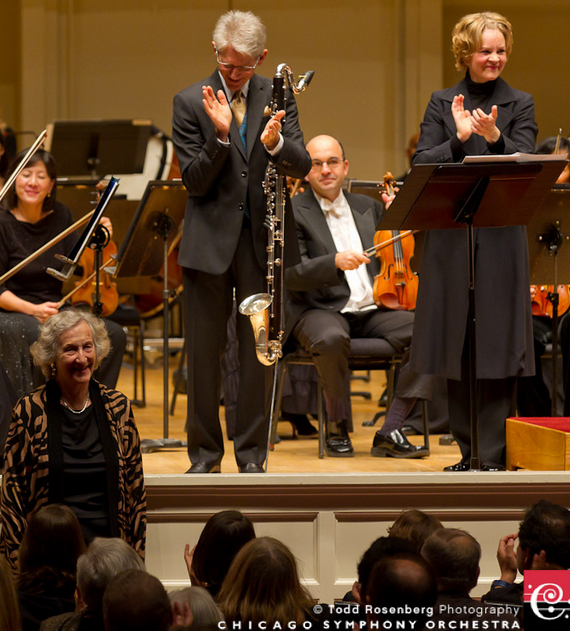Finnish conductor answers every question in CSO debut
 Review: Chicago Symphony Orchestra. Susanna Mälkki, conductor; J. Lawrie Bloom, bass clarinet. At Orchestra Hall through Oct. 18. *****
Review: Chicago Symphony Orchestra. Susanna Mälkki, conductor; J. Lawrie Bloom, bass clarinet. At Orchestra Hall through Oct. 18. *****
By Lawrence B. Johnson
Chutzpah is what it takes for a relatively unknown Finnish conductor to come before the Chicago Symphony Orchestra with a program of Charles Ives and – in Fritz Reiner’s old house, mind you – Richard Strauss.
Well, it doesn’t seem so cheeky now.
Susanna Mälkki, the 42-year-old music director of the Ensemble Intercontemporain in Paris, made her CSO debut Thursday night with a performance that, in every way, placed her among the most important conductors of her generation. While Mälkki stands at the threshold of what surely will be an eminent career, I don’t mean to suggest her gifts are a matter of promise. She is a complete, formidable artist now.
In Ives’ “The Unanswered Question” and “Three Places in New England,” and no less in Strauss’ “Also sprach Zarathustra,” Mälkki displayed an easy brilliance that bespoke intimate understanding of both composers. She also showed a rich technical vocabulary for putting her consistently original ideas across. The CSO answered with an exhilarating performance. It was one of the most remarkable first encounters with a conductor I’ve experienced in a long while.
Ives’ ethereal “Unanswered Question” – for strings, solo trumpet and four flutes – distills into a cosmic echo the great existential conundrum: Why…? Against still-voiced strings, a distant trumpet repeatedly intones the question, to which the prattling flutes keep attempting to offer an answer – until they abandon this eternal dialectic, and the question is left hanging.
Mälkki had only the strings in front of her onstage, their whispered, tremulous sound suggesting an expanse of time and place without end. Above the stage, at the rear, the solitary trumpet posed its big question, to which the four flutes clustered in the mezzanine opposite the stage burbled their hapless replies. It was like gazing at the starry dome of a clear night, with only remote traffic noise to answer the question you can’t help asking aloud.
“Three Places in New England” is not so much a work as it is a pastiche of Ives’ musical ruminations assembled over a period a several years. Still, each of the suite’s three vivid, highly evocative movements characterizes a place, or at least a state of mind Ives associated with those places. With quite a large orchestra now at her disposal, Mälkki created vital portraits that bristled with typical Ivesian rhythmic cross-currents, melodic confluences and harmonic clashes, as well as his considerable gift for expressing the magic of a world at peace.
Between the opulent woodwind hues reminiscent of “St. Gaudens in Boston Common” and the strings’ sparkling image of “The Housatonic at Stockbridge,” Mälkki whipped up a clamorous likeness of military brass bands vying on a festive day at “Putnam’s Camp.” It was clangorous and dazzling, yet at the same time oddly but undeniably precise, a designed madness. And great fun.
Mälkki also offered the U.S. premiere of Thea Musgrave’s 1994 “Autumn Sonata (Concerto for Bass Clarinet and Orchestra),” with the CSO’s J. Lawrie Bloom as soloist.
Musgrave’s unusual work was inspired by the dark, death-themed verses of Georg Trakl, an Austrian poet killed in World War I. This sonata-as-concerto neatly manages the trick of keeping the bass clarinet’s sound in view against an orchestral backdrop, and its shadowy flights of lyricism found a sympathetic and eloquent voice in Bloom. While there’s much to admire in Musgrave’s efficient interplay between solo clarinet and orchestra, the work’s conclusion – an elaborate riff on the first movement of Beethoven’s “Moonlight” Sonata — left one wishing Musgrave had found a more original solution.
Still, the last and best of Susanna Mälkki’s momentous debut was yet to come. A vivacious and clear-sighted “Zarathustra” left no doubt that she is a conductor to be reckoned with.
Beginning with that iconic sunrise fanfare made ubiquitous – and surely trivialized – by the 1968 film “2001: A Space Odyessey,” Strauss’ deftly orchestrated tone poem unfolds through episodes mirroring Nietzsche’s philosophical commentary on the human condition, from issues of religion and science to joy and frailty. That “program” duly noted, what we really have in “Zarathustra” is a colorful, infectious and virtuosic 35-minute suite for orchestra in one movement. And Mälkki led it with a conviction and a panache that made the printed score in front of her seem quite unnecessary.
Strauss’ richly woven textures, which can sound almost opaque in the wrong hands, shone with a rare transparency in Mälkki’s smartly defined voicings. There was a grand sweep to the sound she drew from the CSO, but also a gratifying intimacy as she allowed woodwinds, brasses and strings to have their moments in the sun. This was polished, boldly assertive and thoroughly musical leadership. It should not be a question of whether but when – indeed, how soon – Mälkki returns to the CSO.
Photo captions and credits: Home page and above: Guest conductor Susan Mälkki makes her Chicago Symphony Orchestra debut Oct. 13-18, 2011. (Photo by Simon Fowler.) Below: Composer Thea Musgrave, below the stage, is applauded by Chicago Symphony Orchestra bass clarinetist J. Lawrie Bloom and guest conductor Susanna Mälkki at a performance of Musgrave’s “Autumn Sonata.” (Todd Rosenberg)
Tags: Charles Ives, Chicago Symphony Orchestra, J. Lawrie Bloom, Susan Mälkki, Thea Musgrave


